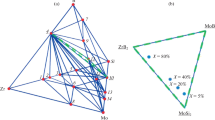Abstract
Micropyretic synthesis is a technique whereby a material is synthesized by the propagation of a combustion front across a powder. Composition variations in reactants and diluent are common during micropyretic synthesis when powders are mixed and the conventional modeling treatments thus far have only considered uniform systems. Composition variations are thought to result in the local variations of such thermophysical/chemical parameters for the reactant as density, heat capacity, and thermal conductivity; the result is changes in the combustion temperature, propagation velocity, and propagation pattern of a combustion front. This study investigates the impact of composition variations during micropyretic synthesis with Ni + Al. Correlations of variations in the reactants and diluent with the propagation velocity and combustion temperature are both studied by a numerical simulation.







Similar content being viewed by others
Abbreviations
- C p :
-
heat capacity of product (general form), kJ/kg/K
- E :
-
activation energy, kJ/kg
- Heterodiluent :
-
heterogeneity in diluent, %
- Heteroreact :
-
heterogeneity in reactants, %
- K 0 :
-
pre-exponential constant, (s-1 for zero order reaction)
- Q :
-
heat of reaction, kJ/kg
- P :
-
porosity, %
- R :
-
gas constant, kJ/kg/K
- R yield,j :
-
reaction yield at node j, %
- T :
-
temperature, K
- T 0 :
-
initial temperature, K
- V i,j :
-
volume fraction of component i at node j, %
- V 0 i :
-
original (homogeneous) volume fraction of component i, %
- X i,j :
-
molar fraction of component i at node j, %
- X 0 i :
-
original (homogeneous) molar fraction of component i, %
- z :
-
dimensional coordinate, m
- d :
-
diameter of the specimen, m
- f R (j):
-
random number at node j
- h :
-
surface heat transfer coefficient, J/m2/K/s
- t :
-
time, s
- ρ:
-
density, kg/m3
- κ:
-
thermal conductivity (general form), kJ/m/K/s
- η:
-
fraction reacted
References
Li HP (2002) J Mater Res 17(12):3213
Li HP (2005) Acta Mater 53(8):2405
Li HP, Bhaduri SB, Sekhar JA (1992) Metall Mat Trans A 24A:251
Li HP, Sekhar JA (1995) J Mater Res 10(10):2471
Naiborodenko YS, Itin VI (1975) Combust Explos Shock Waves 11(3):293
Merzhanov AG, Khaikin BI (1988) Prog Energy Combust Sci 14:1
Shkiro VM, Nersisyan GA (1978) Combust Explos Shock Waves (Engl Transl) 14(1):121
Frolov YV, Pivkina AN (1997) Fizika Goreniya i Vzryva 33(5):3
Hwang S, Mukasyan AS, Rogachev AS, Varma A (1997) Combust Sci Tech 123:165
Merzhanov AG, Peregudov AN, Gontkovskaya VT (1998) Doklady Akademii Nauk 360(2):217
Li HP (2003) Mater Chem Phys 80(3):758
Rogachev AS, Merzhanov AG (1999) Doklady Akademii Nauk 365(6):788
Lakshmikantha MG, Bhattacharys A, Sekhar JA (1992) Metall Trans A 23A:23
Lakshmikantha MG, Sekhar JA (1993) Metall Trans A 24A:617
Lakshmikantha MG, Sekhar JA (1994) J Am Cream Soc 77(1):202
Subramanian V, Lakshmikantha MG, Sekhar JA (1995) J Mater Res 10(5):1235
Li HP, Sekhar JA (1995) J Mater Sci 30(18):4628
Li HP (2003) Mater Metall A 34A(9):1969
Li HP (2003) Mater Sci Eng A 345(1–2):336
Brain I, Knacke O, Kubaschewski O (1973) Thermochemical properties of inorganic substances, Springer-Verlag, New York, NY
Lide DR (1990) CRC handbook of chemistry and physics. CRC, Boca Raton, FL
Brandes EA, Brook GB (1992) Smithells metals reference book. Butterworth-Heinemann Ltd
Li HP (2005) Mater Sci Eng A 392(1–2):262
Acknowledgement
The support from National Center for High-Performance Computing (Account Number: u48hpl00) and National Science Council (Grant Number: NSC94-2216-E-228-001) in Taiwan are acknowledged.
Author information
Authors and Affiliations
Corresponding author
Rights and permissions
About this article
Cite this article
Li, H.P. A numerical study of the effect of heterogeneities in composition on micropyretic synthesis. J Mater Sci 42, 1177–1183 (2007). https://doi.org/10.1007/s10853-006-1450-4
Received:
Accepted:
Published:
Issue Date:
DOI: https://doi.org/10.1007/s10853-006-1450-4




